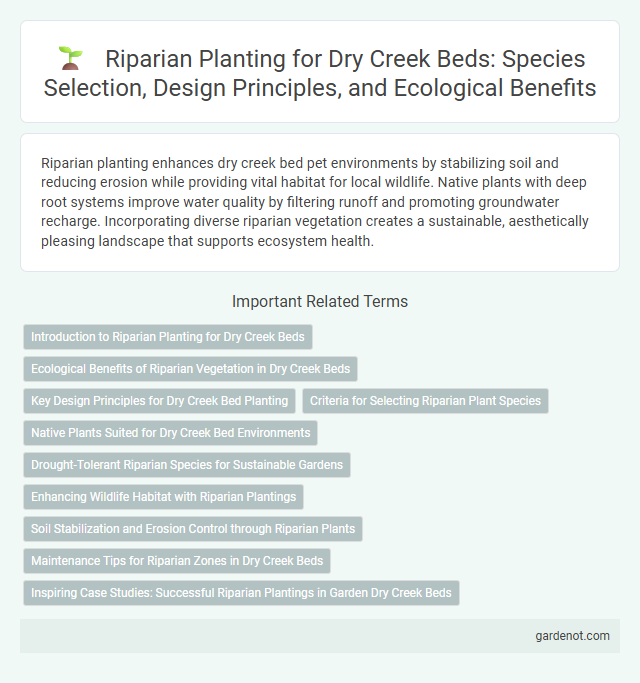Riparian planting enhances dry creek bed pet environments by stabilizing soil and reducing erosion while providing vital habitat for local wildlife. Native plants with deep root systems improve water quality by filtering runoff and promoting groundwater recharge. Incorporating diverse riparian vegetation creates a sustainable, aesthetically pleasing landscape that supports ecosystem health.
Introduction to Riparian Planting for Dry Creek Beds
Riparian planting in dry creek beds stabilizes soil, reduces erosion, and enhances water quality by establishing native vegetation that thrives in intermittent moisture conditions. Selecting drought-tolerant species like willows, sedges, and rushes creates a resilient habitat supporting local wildlife and improving ecological diversity. Integrating deep-rooted plants promotes sediment retention and natural filtration, crucial for sustainable water management in dry stream environments.
Ecological Benefits of Riparian Vegetation in Dry Creek Beds
Riparian vegetation in dry creek beds plays a crucial role in stabilizing soil and reducing erosion by anchoring sediments with deep root systems. These plants enhance biodiversity by providing habitat and food sources for native wildlife, including birds, insects, and small mammals. Moreover, riparian vegetation improves water quality through natural filtration processes, capturing pollutants and promoting groundwater recharge in arid environments.
Key Design Principles for Dry Creek Bed Planting
Riparian planting in dry creek beds emphasizes selecting native, drought-tolerant species that stabilize soil and reduce erosion along water flow paths. Plants should be arranged to mimic natural succession patterns, with deep-rooted shrubs and grasses placed strategically to slow runoff and increase water infiltration. Incorporating diverse vegetation layers enhances habitat complexity and supports local wildlife, improving the ecological function of the dry creek bed.
Criteria for Selecting Riparian Plant Species
Selecting riparian plant species for dry creek beds requires prioritizing drought tolerance, deep root systems for soil stabilization, and adaptability to fluctuating water levels. Native species with high erosion control capability and resistance to local pests enhance ecological resilience and habitat quality. Preference should be given to plants that support native wildlife and improve water filtration to maintain stream health.
Native Plants Suited for Dry Creek Bed Environments
Riparian planting in dry creek bed environments thrives with native plants such as blue grama grass, desert willow, and redbud that are adapted to intermittent water availability and seasonal moisture fluctuations. These native species enhance soil stabilization, support local wildlife habitat, and promote biodiversity by naturally filtering runoff and reducing erosion. Selecting drought-tolerant, deep-rooted native plants maximizes resilience and ecological benefits within dry creek bed landscapes.
Drought-Tolerant Riparian Species for Sustainable Gardens
Drought-tolerant riparian species like willow (Salix spp.), cottonwood (Populus spp.), and red-osier dogwood (Cornus sericea) enhance dry creek bed sustainability by stabilizing soil and providing habitat. These native plants efficiently use limited water resources, reducing irrigation needs while supporting local biodiversity. Incorporating deep-rooted riparian vegetation improves erosion control and promotes resilient garden ecosystems in arid landscapes.
Enhancing Wildlife Habitat with Riparian Plantings
Riparian plantings in dry creek beds significantly enhance wildlife habitat by stabilizing soil, improving water quality, and providing essential food and shelter for diverse species. Native vegetation such as willows, sedges, and cottonwoods supports bird nesting, amphibian breeding, and aquatic insect populations vital for local ecosystems. Restoring these plant communities fosters biodiversity, promoting natural ecological functions and resilience in riparian zones.
Soil Stabilization and Erosion Control through Riparian Plants
Riparian planting along dry creek beds enhances soil stabilization by establishing deep-rooted vegetation that anchors soil particles and reduces erosion from intermittent water flow. Species such as willows, sedges, and rushes thrive in riparian zones, forming dense root networks that absorb water, slow runoff, and prevent sediment loss. Effective riparian vegetation management ensures the protection of creek banks and maintains water quality by minimizing soil displacement and erosion.
Maintenance Tips for Riparian Zones in Dry Creek Beds
Maintaining riparian planting in dry creek beds requires regular monitoring of soil moisture levels to ensure young plants establish strong root systems despite infrequent water availability. Implementing mulch layers and weed control minimizes competition and conserves soil moisture, crucial for native species survival in arid conditions. Periodic inspections for erosion and structural damage to creek banks help sustain the ecological functions and prevent sediment runoff into waterways.
Inspiring Case Studies: Successful Riparian Plantings in Garden Dry Creek Beds
Successful riparian plantings in garden dry creek beds showcase diverse native species like willows, sedges, and rushes that stabilize soil and enhance water filtration. These projects demonstrate improved biodiversity, increased habitat for pollinators, and natural erosion control in urban landscapes. Case studies highlight how strategic plant selection and placement create resilient, self-sustaining creek bed ecosystems that thrive during varying moisture conditions.
Riparian planting Infographic

 gardenot.com
gardenot.com